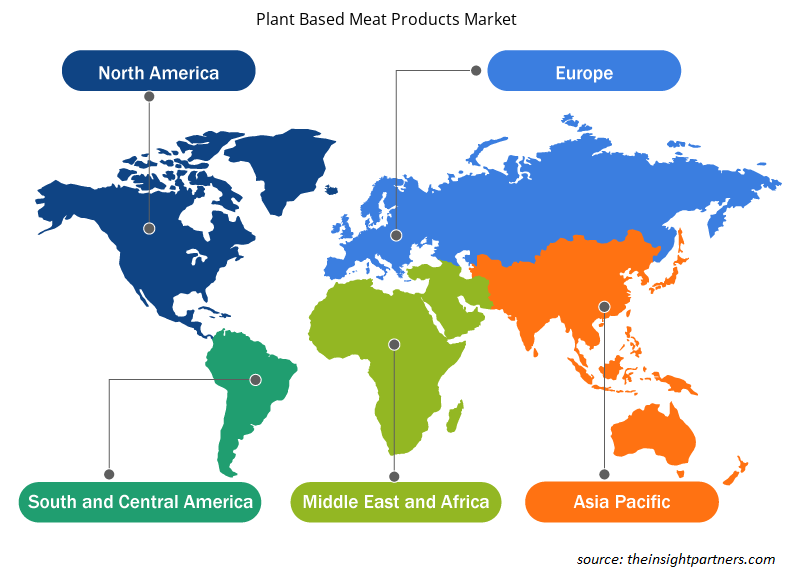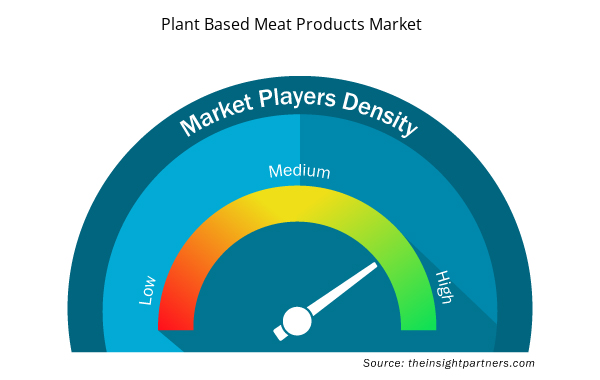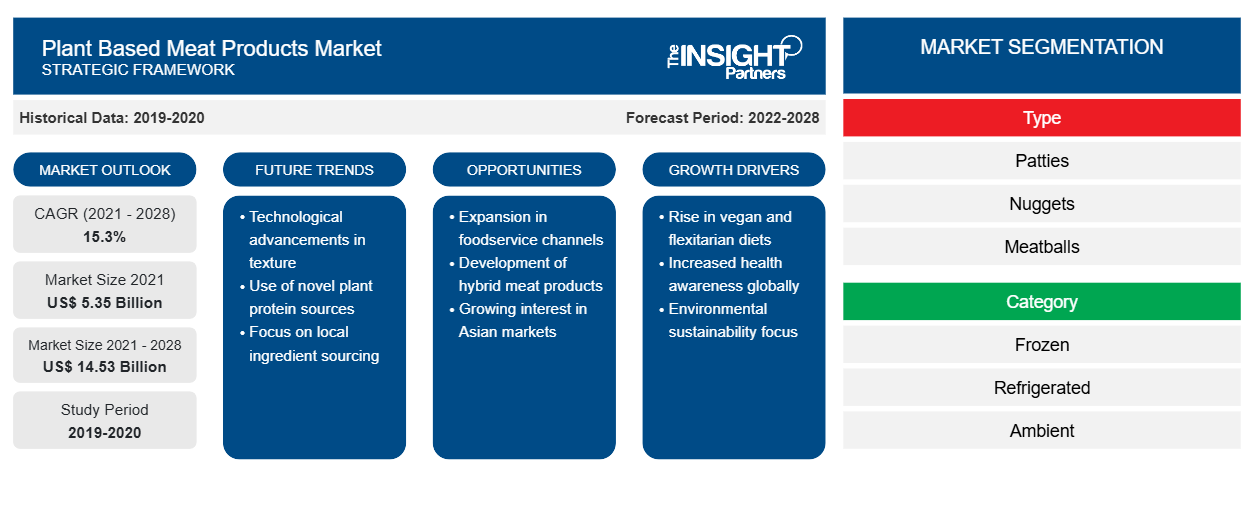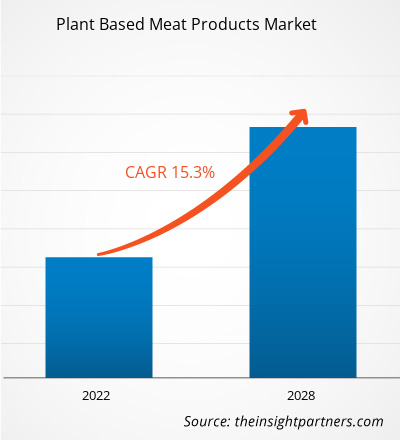[研究报告] 植物基肉制品市场规模预计将从 2021 年的 53.5472 亿美元增至 2028 年的 145.2755 亿美元;预计2021 年至 2028 年的复合年增长率为 15.3%。
市场洞察和分析师观点:
植物肉制品使用植物蛋白制成,例如大豆蛋白、豌豆蛋白和小麦蛋白。大豆蛋白被广泛用于制造植物肉制品,因为它比其他植物蛋白更实惠,并且为产品提供了与传统动物肉制品相似的理想质地。肉饼、鸡块、香肠和肉丸是市场上常见的一些植物肉制品。由于对健康的担忧和对动物福利的认识不断提高,消费者非常倾向于选择植物性或纯素食产品。由于肥胖、糖尿病和其他疾病的患病率不断上升,人们的健康意识不断增强,迫使人们改变饮食习惯。人们普遍认为植物性产品比传统的动物性产品更健康。这一因素极大地推动了植物性肉制品市场的增长
增长动力和挑战:
植物性肉制品的饱和脂肪和卡路里含量低于传统肉制品,因此是一种更健康的选择。这一因素推动了植物性肉制品市场的增长。素食主义趋势的兴起也归因于人们对动物的同情心日益增加。人们对屠宰场和工厂虐待动物的认识不断提高,引起了消费者对动物保护的担忧。这一因素也有望促进植物性食品的消费,推动植物性肉制品市场的发展。然而,其高昂的价格限制了对价格敏感的消费者对其的接受。在 Kroger 和沃尔玛等领先的连锁超市,Beyond Meat 的两个植物性汉堡肉饼售价约为 5.99 美元。另一方面,2 磅碎牛肉的价格大致相同,可以生产出 10 倍的汉堡肉饼。因此,在比较价格后,消费者通常会购买传统肉类而不是植物性肉类,这阻碍了植物性肉制品市场的增长。制造商正致力于实现规模经济,以降低生产植物肉产品所需的总体成本。这种举措可能有助于制造商即使在价格敏感的市场中也能获得新客户。
定制此报告以满足您的需求
您可以免费定制任何报告,包括本报告的部分内容、国家级分析、Excel 数据包,以及为初创企业和大学提供优惠和折扣
- 获取此报告的关键市场趋势。这个免费样品将包括数据分析,从市场趋势到估计和预测。
报告细分和范围:
“全球植物性肉制品市场”根据类型、类别、分销渠道和地理位置进行细分。根据类型,植物性肉制品市场细分为肉饼、鸡块、肉丸、香肠等。根据类别,植物性肉制品市场细分为冷冻、冷藏和常温。根据分销渠道,植物性肉制品市场细分为超市和大卖场、便利店、在线零售等。根据地理位置,植物性肉制品市场细分为北美(美国、加拿大和墨西哥)、欧洲(德国、法国、意大利、英国、俄罗斯和欧洲其他地区)、亚太地区(澳大利亚、中国、日本、印度、韩国和亚太地区其他地区)、中东和非洲(南非、沙特阿拉伯、阿联酋和中东和非洲其他地区)以及南美洲和中美洲(巴西、阿根廷和南美洲和中美洲其他地区)
节段分析:
根据类型,植物肉制品市场分为肉饼、肉块、肉丸、香肠等。2021 年,肉饼在植物肉制品市场中占有最大份额。
根据分销渠道,植物肉产品市场细分为超市和大卖场、便利店、在线零售和其他。超市和大卖场细分市场在 2021 年占据了最大的市场份额,而在线零售细分市场预计在预测期内将实现最高的复合 年增长率。在线零售是增长最快的分销渠道之一,因为它在购物和产品配送方面都很方便。在线零售商店提供各种各样的产品,并提供大幅折扣;此外,消费者还可以方便地远程购买理想的产品。送货上门服务吸引了大量客户通过电子商务平台购物。电子商务网站提供详细的产品信息以及用户评论,帮助买家比较产品并做出明智的决定。这些因素将在未来几年极大地推动该细分市场的增长。
区域分析:
根据地理位置,植物性肉制品市场分为五个主要区域:北美、欧洲、亚太、南美和中美以及中东和非洲。2021 年,欧洲全球植物性肉制品市场规模为 20.603 亿美元。北美是第二大贡献者,在全球市场中占有 30% 以上的份额。亚太地区也是植物性肉制品的主要市场之一,复合年增长率约为 15%。由于对动物福利的认识不断提高,消费者对植物性产品非常倾向于使用植物性产品。无胆固醇蛋白质食品具有类似肉类的质地,其好处促进了欧洲植物性肉制品市场的增长。此外,随着消费者对植物性肉制品的倾向不断增加,制造商正在采用产品开发和扩张等增长战略来满足消费者不断增长的需求。例如,Plant & Bean 于 2020 年 12 月在波士顿和林肯郡(英国)开设了一家植物肉工厂,服务于欧洲市场。该工厂原有产能为每年生产5.5万吨植物肉。
行业发展和未来机遇:
以下列出了植物肉制品市场的主要参与者采取的各种举措:
- 2022年12月,联合超市控股公司推出了由Beyond Meat公司打造的植物性肉类替代品“BEYOND BEEF”。BEYOND BEEF是一种类似碎牛肉的植物性替代品,可以替代传统的碎牛肉,可用作汉堡肉饼、肉丸等各种菜肴的配料。
- 2022 年 10 月,印度公司 Licious 推出了植物肉品牌“UnCrave”,其产品组合包括植物鸡肉和羊肉烤肉串。
- 2022 年 3 月,Beyond Meat 与百事可乐成立合资企业“Planet Partnerships LLC”,推出采用豌豆和绿豆等 100% 植物成分制成的 Beyond Meat 肉干。
植物性肉制品市场区域洞察
Insight Partners 的分析师已详细解释了预测期内影响植物性肉制品市场的区域趋势和因素。本节还讨论了北美、欧洲、亚太地区、中东和非洲以及南美和中美洲的植物性肉制品市场细分和地理位置。

- 获取植物性肉制品市场的区域特定数据
植物性肉制品市场报告范围
| 报告属性 | 细节 |
|---|---|
| 2021 年市场规模 | 53.5亿美元 |
| 2028 年市场规模 | 145.3亿美元 |
| 全球复合年增长率(2021 - 2028) | 15.3% |
| 史料 | 2019-2020 |
| 预测期 | 2022-2028 |
| 涵盖的领域 | 按类型
|
| 覆盖地区和国家 | 北美
|
| 市场领导者和主要公司简介 |
|
植物性肉制品市场参与者密度:了解其对业务动态的影响
植物性肉制品市场正在快速增长,这得益于终端用户需求的不断增长,这些需求源于消费者偏好的不断变化、技术进步以及对产品优势的认识不断提高等因素。随着需求的增加,企业正在扩大其产品范围,进行创新以满足消费者的需求,并利用新兴趋势,从而进一步推动市场增长。
市场参与者密度是指在特定市场或行业内运营的企业或公司的分布情况。它表明在给定市场空间中,相对于其规模或总市场价值,有多少竞争对手(市场参与者)存在。
在植物性肉制品市场运营的主要公司有:
- 超越肉类
- 康尼格拉品牌公司
- 凯洛格
免责声明:上面列出的公司没有按照任何特定顺序排列。

- 获取植物性肉类产品市场顶级关键参与者概览
Covid-19的影响:
COVID-19 疫情影响了各个国家几乎所有行业。北美、欧洲、亚太地区 (APAC)、南美和中美 (SAM) 以及中东和非洲 (MEA) 的封锁、旅行限制和企业关闭阻碍了多个行业的增长,包括食品和饮料行业。在 COVID-19 疫情的初期,严重的供应链中断导致原材料短缺,从而导致原材料价格上涨。根据美国农业部 (USDA) 的数据,豌豆蛋白(植物肉常用成分之一)的价格因供应链中断而上涨。这导致价格上涨,对植物肉产品的需求产生负面影响。然而,由于消费者饮食偏好的重大转变,COVID-19 疫情爆发后对植物肉产品的需求急剧增加。世界卫生组织 (WHO) 发布了一份关于 COVID-19 疫情期间应食用的食品的指南。该指南建议限制红肉的消费,因为红肉的饱和脂肪比例很高。此外,人们注重减少整体肉类消费,转向素食和纯素食以提高免疫力。这些因素对植物肉制品市场的增长产生了积极影响。
竞争格局和重点公司:
全球植物肉制品市场的一些知名参与者包括Beyond Meat;Conagra Brands, Inc.;Impossible Foods Inc.;Quorn Foods, Inc.;Kellogg Company;Hilary's Eat Well;Vbites Foods, Ltd.;Before the Butcher;Field Roast;以及 Tofurky 等。这些公司积极参与产品创新和新产品开发,以增强其专业知识并扩大其产品组合。此外,这些公司还与行业中的其他参与者合作,以满足更广泛的客户群。这些举措预计将为植物性肉制品市场的主要行业参与者提供强劲的增长潜力。
- 历史分析(2 年)、基准年、预测(7 年)及复合年增长率
- PEST 和 SWOT 分析
- 市场规模价值/数量 - 全球、区域、国家
- 行业和竞争格局
- Excel 数据集


- Truck Refrigeration Market
- Legal Case Management Software Market
- Wheat Protein Market
- Europe Industrial Chillers Market
- Clinical Trial Supplies Market
- Medical Devices Market
- Helicopters Market
- Lyophilization Services for Biopharmaceuticals Market
- Electronic Shelf Label Market
- Lymphedema Treatment Market

Report Coverage
Revenue forecast, Company Analysis, Industry landscape, Growth factors, and Trends

Segment Covered
This text is related
to segments covered.

Regional Scope
North America, Europe, Asia Pacific, Middle East & Africa, South & Central America

Country Scope
This text is related
to country scope.
常见问题
Europe accounted for the largest share of the global plant-based meat products market. Europe has emerged as a significant plant-based meat products market due to considerable demand for animal-meat alternatives from consumers owing to increasing health consciousness and the rising veganism trend.
The growing importance of environmental sustainability is expected to significantly drive the development of the plant-based meat products market over the forecast period. Also, the growth of the veganism trend is also attributed to growing affiliation with animals. Animals are ill-treated in slaughterhouses and factor which is raising concerns related to animal protection among consumers. This factor is also expected to boost the consumption of plant-based food. Thus, rising veganism and vegetarianism trends are projected to significantly drive the growth of the plant-based meat products market over the forecast period.
The major players operating in the global plant-based meat products market are Beyond Meat; Conagra Brands, Inc.; Kellogg’s Company; Tofurky; Field Roast; Before the Butcher; VBites Foods Inc.; Hilary’s – Drink Eat Well, LLC.; Quorn; and Impossible Foods Inc.
Plant-based meat is experiencing strong demand in emerging regions like the Asia Pacific and the Middle East & Africa. Rising demand for low or no meat diets owing to shifting consumer priorities towards sustainability and wellness is driving the plant-based meat industry across the Asia Pacific. On the other hand, plant-based meat is also gaining huge traction across the Middle East & Africa as consumers in the region are reducing their meat consumption in an attempt to lead a sustainable and healthy life. Thus, the surging demand for plant-based meat in emerging regions will provide a strong market potential over the forecast period.
The market scope for global plant-based meat products takes into consideration the retail sale of plant-based meat products and not the foodservice consumption.
Based on distribution channel, the supermarkets and hypermarkets segment accounted for the largest revenue share as the increasing urbanization, rising working-class population, and competitive pricing are boosting the popularity of supermarkets and hypermarkets in developed and developing regions. Moreover, manufacturers of plant-based meat products usually prefer to sell their products through supermarkets and hypermarkets owing to a heavy customer base.
Trends and growth analysis reports related to Food and Beverages : READ MORE..
The List of Companies - Plant-Based Meat Products Market
- Beyond Meat
- Conagra Brands, Inc.
- Kellogg’s Company
- Tofurky
- Field Roast
- Before the Butcher
- VBites Foods Inc.
- Hilary’s – Drink Eat Well, LLC.
- Quorn
- Impossible Foods Inc.
The Insight Partners performs research in 4 major stages: Data Collection & Secondary Research, Primary Research, Data Analysis and Data Triangulation & Final Review.
- Data Collection and Secondary Research:
As a market research and consulting firm operating from a decade, we have published and advised several client across the globe. First step for any study will start with an assessment of currently available data and insights from existing reports. Further, historical and current market information is collected from Investor Presentations, Annual Reports, SEC Filings, etc., and other information related to company’s performance and market positioning are gathered from Paid Databases (Factiva, Hoovers, and Reuters) and various other publications available in public domain.
Several associations trade associates, technical forums, institutes, societies and organization are accessed to gain technical as well as market related insights through their publications such as research papers, blogs and press releases related to the studies are referred to get cues about the market. Further, white papers, journals, magazines, and other news articles published in last 3 years are scrutinized and analyzed to understand the current market trends.
- Primary Research:
The primarily interview analysis comprise of data obtained from industry participants interview and answers to survey questions gathered by in-house primary team.
For primary research, interviews are conducted with industry experts/CEOs/Marketing Managers/VPs/Subject Matter Experts from both demand and supply side to get a 360-degree view of the market. The primary team conducts several interviews based on the complexity of the markets to understand the various market trends and dynamics which makes research more credible and precise.
A typical research interview fulfils the following functions:
- Provides first-hand information on the market size, market trends, growth trends, competitive landscape, and outlook
- Validates and strengthens in-house secondary research findings
- Develops the analysis team’s expertise and market understanding
Primary research involves email interactions and telephone interviews for each market, category, segment, and sub-segment across geographies. The participants who typically take part in such a process include, but are not limited to:
- Industry participants: VPs, business development managers, market intelligence managers and national sales managers
- Outside experts: Valuation experts, research analysts and key opinion leaders specializing in the electronics and semiconductor industry.
Below is the breakup of our primary respondents by company, designation, and region:

Once we receive the confirmation from primary research sources or primary respondents, we finalize the base year market estimation and forecast the data as per the macroeconomic and microeconomic factors assessed during data collection.
- Data Analysis:
Once data is validated through both secondary as well as primary respondents, we finalize the market estimations by hypothesis formulation and factor analysis at regional and country level.
- Macro-Economic Factor Analysis:
We analyse macroeconomic indicators such the gross domestic product (GDP), increase in the demand for goods and services across industries, technological advancement, regional economic growth, governmental policies, the influence of COVID-19, PEST analysis, and other aspects. This analysis aids in setting benchmarks for various nations/regions and approximating market splits. Additionally, the general trend of the aforementioned components aid in determining the market's development possibilities.
- Country Level Data:
Various factors that are especially aligned to the country are taken into account to determine the market size for a certain area and country, including the presence of vendors, such as headquarters and offices, the country's GDP, demand patterns, and industry growth. To comprehend the market dynamics for the nation, a number of growth variables, inhibitors, application areas, and current market trends are researched. The aforementioned elements aid in determining the country's overall market's growth potential.
- Company Profile:
The “Table of Contents” is formulated by listing and analyzing more than 25 - 30 companies operating in the market ecosystem across geographies. However, we profile only 10 companies as a standard practice in our syndicate reports. These 10 companies comprise leading, emerging, and regional players. Nonetheless, our analysis is not restricted to the 10 listed companies, we also analyze other companies present in the market to develop a holistic view and understand the prevailing trends. The “Company Profiles” section in the report covers key facts, business description, products & services, financial information, SWOT analysis, and key developments. The financial information presented is extracted from the annual reports and official documents of the publicly listed companies. Upon collecting the information for the sections of respective companies, we verify them via various primary sources and then compile the data in respective company profiles. The company level information helps us in deriving the base number as well as in forecasting the market size.
- Developing Base Number:
Aggregation of sales statistics (2020-2022) and macro-economic factor, and other secondary and primary research insights are utilized to arrive at base number and related market shares for 2022. The data gaps are identified in this step and relevant market data is analyzed, collected from paid primary interviews or databases. On finalizing the base year market size, forecasts are developed on the basis of macro-economic, industry and market growth factors and company level analysis.
- Data Triangulation and Final Review:
The market findings and base year market size calculations are validated from supply as well as demand side. Demand side validations are based on macro-economic factor analysis and benchmarks for respective regions and countries. In case of supply side validations, revenues of major companies are estimated (in case not available) based on industry benchmark, approximate number of employees, product portfolio, and primary interviews revenues are gathered. Further revenue from target product/service segment is assessed to avoid overshooting of market statistics. In case of heavy deviations between supply and demand side values, all thes steps are repeated to achieve synchronization.
We follow an iterative model, wherein we share our research findings with Subject Matter Experts (SME’s) and Key Opinion Leaders (KOLs) until consensus view of the market is not formulated – this model negates any drastic deviation in the opinions of experts. Only validated and universally acceptable research findings are quoted in our reports.
We have important check points that we use to validate our research findings – which we call – data triangulation, where we validate the information, we generate from secondary sources with primary interviews and then we re-validate with our internal data bases and Subject matter experts. This comprehensive model enables us to deliver high quality, reliable data in shortest possible time.


 获取此报告的免费样本
获取此报告的免费样本